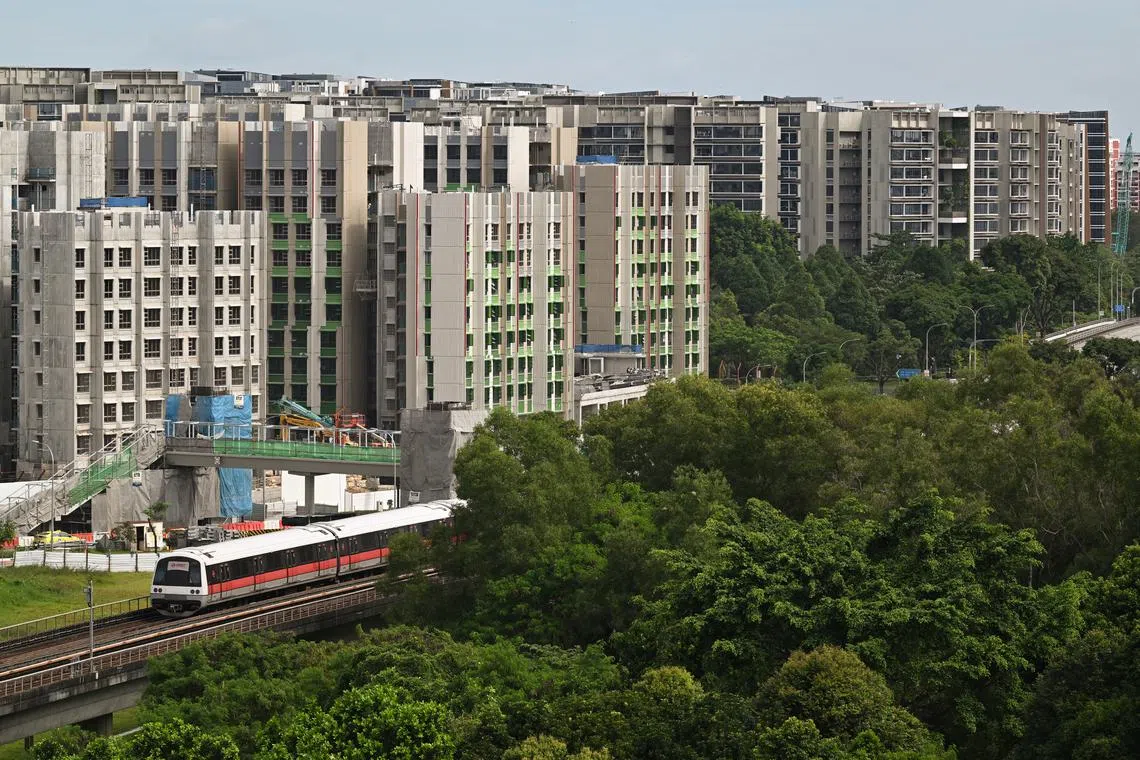‘We will turn the corner soon’: Desmond Lee says nearly 100,000 homes slated to be ready by 2025
Sign up now: Get ST's newsletters delivered to your inbox

The increased supply should help to alleviate some pressure in the rental market.
ST PHOTO: LIM YAOHUI
Follow topic:
SINGAPORE - Close to 100,000 private and public homes are expected to be completed between 2023 and 2025, as Singapore ramps up construction to make up for delays caused by the Covid-19 pandemic.
Of the 100,000 homes, almost 40,000 are expected to be ready in 2023 – the highest in the past five years, including the pre-pandemic years of 2018 and 2019, National Development Minister Desmond Lee said on Thursday.
This includes about 20,000 HDB flats across 22 housing projects, he told the House.
“Our first priority is to catch up on lost time, and deliver keys to Singaporeans who have been waiting for their homes,” he said. “My colleagues have been working very hard, and we will turn the corner soon.”
The increased housing supply should help alleviate some pressure in the rental market, as those who had been waiting for their keys will stop renting and the new homes will provide additional rental supply, Mr Lee said in response to Workers’ Party MP Louis Chua (Sengkang GRC), who had raised the issue of soaring rents.
Mr Lee said the Housing Board has also ramped up the supply of Build-To-Order (BTO) flats, and is now “building aggressively and on a very large scale”.
There are now 100 BTO projects ongoing islandwide, and this will increase to more than 150 concurrent projects by 2025,
Responding to MPs who asked why HDB cannot build more flats or build them even faster, Mr Lee said land preparation is a “long and complex process”, as much of the land for housing are not large, undeveloped greenfield sites that can be constructed on readily.
Preparation for greenfield sites includes ensuring supporting infrastructure such as roads and sewers are ready, and conducting extensive soil investigations, he said.
Brownfield sites, meanwhile, may require relocating existing users of the site, clearing existing structures and diverting services underground such as cables and sewers.
Impact studies and public engagements will be conducted for sites with ecological and heritage significance, Mr Lee said.
An example is the Old Police Academy site at Mount Pleasant, where studies and engagements began in 2018, seven years before HDB will launch the first BTO project there in 2025.
“So, lots of forward planning and preparation is required before we can even begin construction – about five to 10 years of lead time – or even more in some cases,” said Mr Lee.
On top of that, the pace of construction across public and private sectors is going up significantly, he added. “Resources, manpower and construction capacity are not without their limits.”
Mr Chua had also suggested a “fundamental rethink of the BTO system”, as long waiting times for a flat are not just an inconvenience, but also seriously affect Singaporeans’ life and family plans.
In response, Mr Lee said Singapore’s public housing system is “not perfect”, and needs to be continually improved.
He recounted how the now-defunct Registration for Flats System (RFS) – a queue system that allowed people to buy flats on a first-come, first-served basis – was replaced by the BTO model in 2002, as it could not cope with sharp shifts in demand.
The wait for a flat under the RFS was as long as seven years at the height of the property boom in the mid-90s, but HDB was left with 31,000 unsold flats, which took many years to sell after demand plummeted when the Asian financial crisis hit in 1997.
This had a very serious impact on the value of existing homes in the resale market, Mr Lee noted.
Over the years, the public housing system has been further refined to a more comprehensive model comprising BTO flats, flats with waiting time of three years or less, Sale of Balance flats and open booking flats, he said.
“This combination allows us to more dynamically adjust our building plans in response to demand,” he said, noting that supply can be ramped up to meet immediate needs or scaled back to minimise the potential for oversupply.
“The current system may not always work perfectly, and we will continue to adjust and calibrate along the way,” he added.
“But it does seem to strike a reasonable balance across multiple objectives – fairness and efficiency in allocating flats, fiscal prudence and responsiveness to demand.”
Near the end of the debate, Leader of the Opposition Pritam Singh (Aljunied GRC) asked for an update on the reclassification of mature and non-mature estates, and whether it will be part of the Forward Singapore exercise.
In response, Mr Lee said his ministry has gathered views through engagements and is studying the issue and how to enhance the public housing system.
Progress Singapore Party Non-Constituency MP Leong Mun Wai asked if the Government will continue to cover HDB’s annual deficit, which has grown year on year, and whether it is fair for Singaporeans to pay higher taxes to fund it.
Mr Lee said expenditures have gone up largely due to the ramp-up in supply, HDB building flats with more complex designs and a 30 per cent increase in construction costs.
He added that the current imbalance in property supply and demand has led to greater demand and higher resale prices.
The Government is committed to managing this supply-demand distortion and stabilising the property market, he said.
“We will make sure that we spend the resources to tackle this issue, in order to provide affordable, accessible housing for Singaporeans. And I think Singaporeans do certainly expect that,” said Mr Lee.


